| Chernobyl Catastrophe, the world’s worst nuclear accident |
|
Early on April 26, 1986, a major explosion occurred at the Unit 4 of a nuclear power station at Chernobyl, Ukraine.
The explosion devastated the nuclear reactor in an instant, triggering a fire. Some 5,000 tons of sand and lead were dropped on to the burning core by helicopters to extinguish the blaze. The operation was continued for 14 days after it broke out. On May 10, the fire was finally put out.
|
| Contamination spreading worldwide |
|
The nuclear accident released tremendous amount of radioactivity (*) into the atmosphere. The radioactive fallout was carried by the wind across international boarders, spreading abound the world. It was also detected from vegetables, water, and breast milk in Japan as far as 8,000km from the Chernobyl.
* Radioactivity is the term used to describe the ability of radioactive materials to emit radiation. In many cases (also here), however, the ability is used in same way as radioactivity.
|
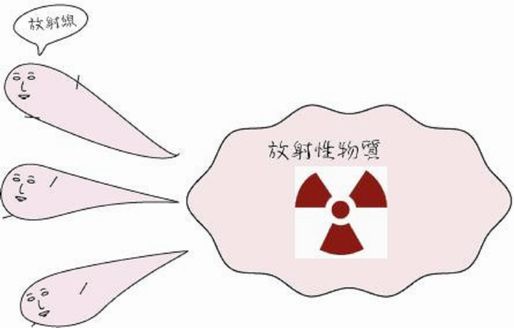
|
| Radioactivity and Radiation (Image) |
*Column 1: What is nuclear energy? |
|
Nuclear energy is produced by nuclear fission of uranium, also known as atomic fission.An atom is the smallest particle that can not be cut into smaller particle in the world, which is composed of a nucleus (neutrons and protons) and electrons.
When neutron is absorbed by uranium, the nuclear fission event was induced to release massive thermal energy.Nuclear power stations utilize this thermal energy to produce nuclear energy.
|
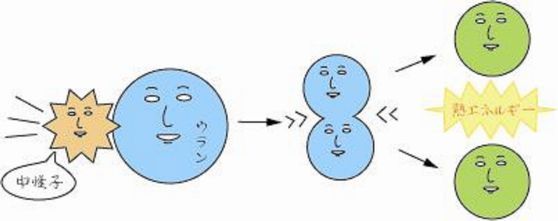
|
| Nuclear fission of Uranium (Image) |
| Evacuation day |
|
It was a sunny day. In Pripyat, known as city of Chernobyl’s workers, most residents heard about the Chernobyl accident in the same day when it happened. However, many people were spending the day as usual like going shopping and playing out in the playground. Only a small number of people stayed indoors for fear of being exposed to radioactivity.
Around noon on April 27, evacuation was announced on the local Pripyat radio. The residents were told to leave their home with their identity cards and foods for three days. Most of them believed that they were leaving their homes for about three days.
However, they would never return.
Meanwhile, for residents who lived on the outskirts of the city 30km around the reactor, particularly in rural areas, no information about the accident was provided for one week. On May 2, one week following the accident, their compulsory evacuation started. It taking nearly one week to complete the evacuation of hundreds of thousands of residents and their livestock. The number totaled about 120,000 people.
|
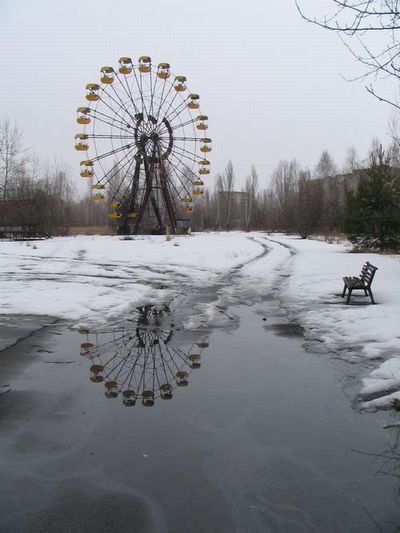
|
Ferris wheel in ghost town Pripyat without people
No body during closing time when exposure occurred |
| Fire Fighting and construction of concrete ‘sarcophagus’ |
|
People who involved in fire fighting and cleaning up radiation ash after the disaster is called “Liquidator”, Chernobyl clean-up workers.
They cleared out the radioactive rubble from the ruins of the power plant by hand. Following that, a massive concrete ‘sarcophagus’ was built over the Unit 4 to keep radiation inside the plant.
The exact number of liquidators was not known, however, 600,000 to 800,000 were estimated to participate in the operation.
Bodies of 27 liquidators involved in fire fighting were buried in coffins made of lead in the grave of ミチノ, Moscow. Their bodies were so radioactive that they had never been committed directly to the earth.
|
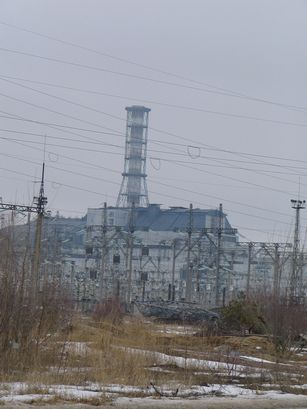 |
Concrete sarcophagus covering Unit 4
|
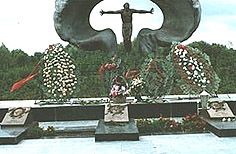 |
| Chernobyl Heroes buried in the grave of ミチノ |
| Extensive radioactive contamination |
|
The radioactive contamination spread over large areas. More than 200km zone surrounding the reactor was affected by highly radioactive contamination. Many kinds of radioactive materials were released into the atmosphere resulting from the disaster.
Among them, iodine-131was the main cause of radioactive exposure. Iodine-131 has a relatively short half-life (*) as 8 days, however, the exposure causes specific damage to thyroid (see column 2). Many children were severely affected by thyroid cancer or dysfunction resulting from the iodine-131 exposure.
* The length of time it takes a radioactive substance to lose half of its radioactivity
Meanwhile, cesium-137 contamination is long-term consequences. Its half-life is as long as 30 years. Cesium-137 was carried away to a long distance, contaminating foods. People who ate the foods were affected by internal exposure as well as external exposure. The internal exposure is that skin surface is exposed to radioactivity while the external exposure is that inside body is exposed to radioactivity after the intake of radioactive air, water and foods.
It is said that the Chernobyl accident released hundred of times as much radioactive cesium-137 as that of the Hiroshima atomic bomb.
Radioactivity causes the contamination to ground, water, air and all living things in the ground. The total affected areas were estimated at 145,000km2 in Russia, Ukraine and Belarus. About 6,000,000 residents are forced to live in the contamination regions.
|
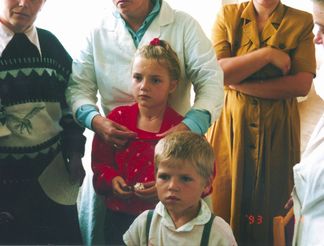 |
A girl after thyroid cancer treatmentDeep scar on her neck
|
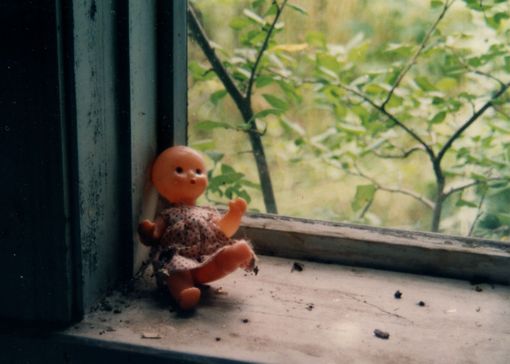 |
| Doll left in village after evacuation |
| Radioactive exposure results in increase in thyroid cancer |
|
There has been rapid increase in thyroid cancer among children since around 1990 after the Chernobyl disaster. The main cause is exposure to radioactivity by the inhalation of iodine-131 into their thyroid.
Thyroid cancer among the Chernobyl children had decreased after peaking in 1995. However, this is not because incidence of thyroid cancer among the children has decreased, but because they got older and categorized into the group of teenagers.
|
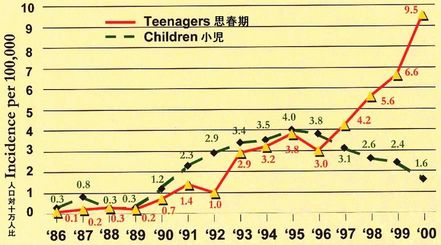
|
| Incidence of thyroid cancer in children and teenagers |
|
Thyroid cancer is only a case that the causes and effects are officially confirmed, however, there have been many cases reported that leukemia and other diseases has increased following the accident.
|
*Column 2: What is Thyroid? |
|
Thyroid is a butterfly-shaped gland located in the neck, producing thyroid hormone from iodine which is contained mainly in seaweed and kelp. The hormone plays an important role in growth, development and metabolism in the body. The thyroid of growing children is more likely to absorb iodine than that of adult.
The Chernobyl accident released radioactive iodine (iodine-131) into the atmosphere. An increasing number of children suffered from thyroid abnormality after the intake of iodine into their thyroid.
|
| Liquidators after Chernobyl |
|
Liquidators had been exposed to extremely strong radioactivity for several days during the period of fire fighting and clean-up operation at the site. Some had suffered from severe burn, hair loss and rash while the others died from cancer and leukemia after the operation. Damage to their children has also been confirmed, however, the cause is still not known.
Seeing their co-worker died one after another, some people had became depend on alcohol, the others committed suicides in despair over their future.
|
| サマショール |
|
After the release of radioactivity, more than 500 of affected towns and villages disappeared from the map. The residents were forced to give up their life base on community in rural areas and headed to new cities. Many people couldn’t adjust to a new environment, which caused damage to their health.
Radioactive contamination cast a shadow in many aspect of their life. Among them, some people could not fit into a new life and come back their home inside the prohibited zone. They are known as “サマショール”, Russian for egoistic people.
|
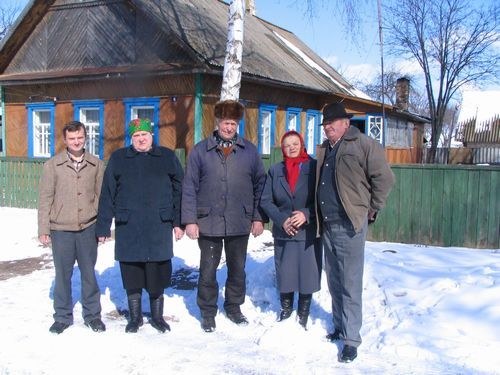
|
| People living in the restricted zone |
20 years after Chernobyl Disaster
―Live with Chernobyl― |
|
It has been more than 20 years since the Chernobyl disaster. Recently, houses in the “villages disappearing from the map” without their owners have began to be resided by new owners from various areas of the former Soviet Union including Russia, Georgia, Armenia, Kazakhstan, Chechen, and Belarus.
In Belarus, workers in the contaminated areas are paid a good salary as a part of restoration measurements for the disaster. Many immigrants to the villages off the map say they seek a place to live in peace without ethnic conflicts and unemployment.
They say they have no fear for invisible enemy of radioactivity. Their real enemies are visible enemy like guns, wars and economic uncertainty under which they had been forced to live.
|
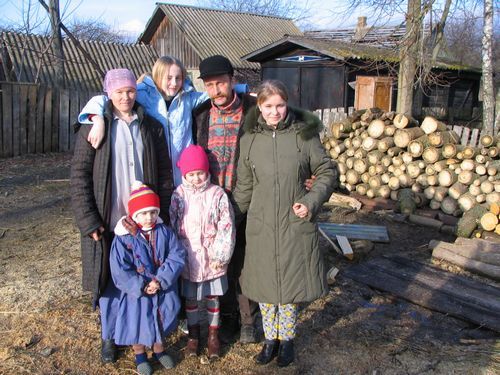
|
Family immigrated from Kazakhstan to seek a better life in new ground
They says they do not scare radioactivity,
because they had an experience to live near uranium mine in their home town |
| Chernobyl as a tourist site |
|
More than 20 years has past since the world had been shocked and shaken by the Chernobyl nuclear catastrophe. Recently, a local travel agency in Kiev, Ukraine organized a tour of the Chernobyl restricted area, attracting many tourists around the world. There are also some offers to use the site as a filming location for movies. In Pripyat, a city of the Chernobyl’s workers, we can see many graffiti the visitors left on the wall.
|
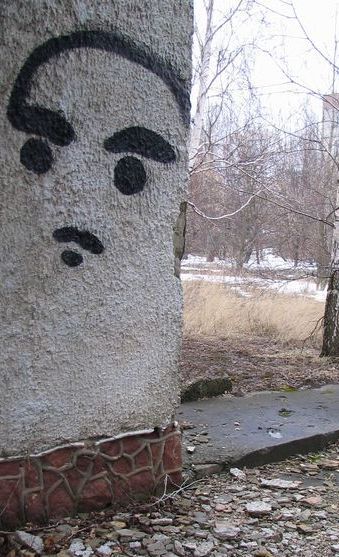
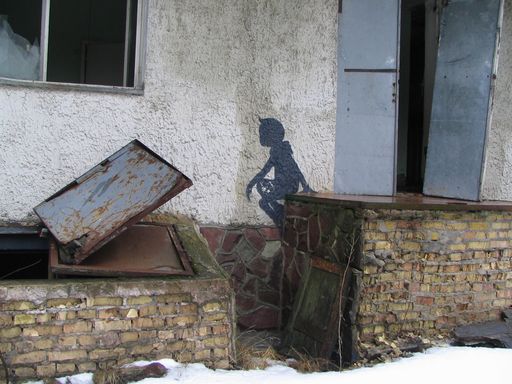
|
| Graffiti in Pripyat |
|
In ラッソハ village, meanwhile, located by a landfill site for the disposal of radioactive wastes, there are many armed trucks and mobile cranes used in clean-up operation as well as buses for evacuation waiting to be dismantled for a long period.
The level of radioactivity is too high to show overgauge even when it has been 20 years since the Chernobyl disaster. Such negative legacy has co-existed with growing tourism in Chernobyl.
|
 |
Armed helicopter for fire fighting at Chernobyl Unit 4
Many weapons used to fight against peaceful use of nuclear power plant
|
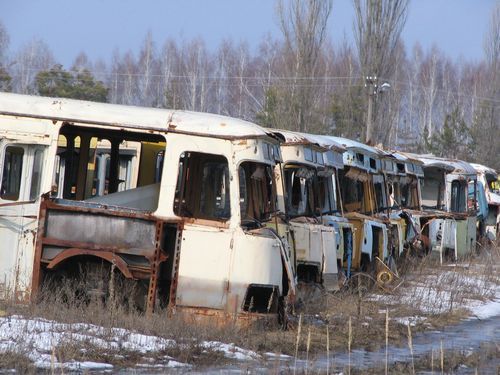 |
| Buses used in emergency evacuation |
| Aging nuclear plant and Plan of the 2nd concrete sarcophagus |
|
The Chernobyl Unit 4 was covered by a concrete sarcophagus to prevent the leak of radioactivity.
Recently, however, the sarcophagus has got aging during the past 20 years, endangered by the possibility of breakdown. Groundwater contamination is also a grave concern, as a result of radioactive rain water leaked from cracks. The construction of the “new sarcophagus” is now being planned to prevent such risks.
|
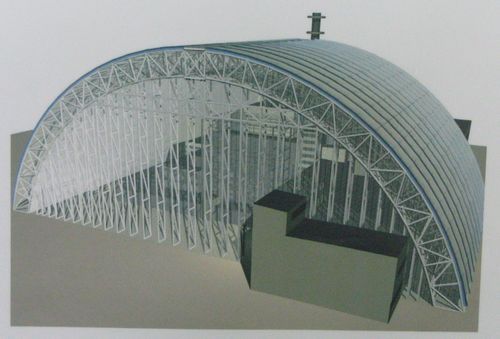
|
| Plan of the 2nd concrete sarcophagus (Ministry of Emergency of Ukraine) |
| Chernobyl Children |
|
People exposed to radioactivity are likely to develop thyroid cancer over a long time of period. No signs and symptoms can be observed in the early stages of thyroid cancer.
It was found that the incident of the Chernobyl-related thyroid cancer recorded the high rate among children aged 6 or younger at that time. Now those children grow up into adult aged 20 to 26, who are most vulnerable to thyroid cancer in the future.
The demand on normal thyroid function increases especially for women during pregnancy and childbirth. Early detection and proper treatment are the best ways to reduce these risks.
|
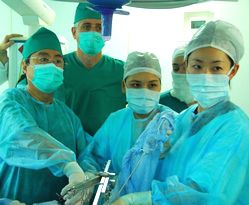
|
Woman born three days after the Chernobyl accident on April 26, 1986.
After 20 years, Chernobyl children grow up to get married, and pregnant
|


